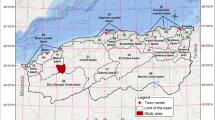Abstract
An environmental impact assessment model for soil remediation was developed to evaluate the environmental impacts of the remedial activities in both qualitative and quantitative way. It is a Microsoft Excel-based program containing seven soil remediation alternatives for South Korea. Qualitative evaluation provides a set of a checklist, and users can evaluate the environmental impacts by filling in the checklists. Four in-situ and three ex-situ remedial schemes are available in the quantitative evaluation. In quantitative evaluation, the quantities of energy, CO2, SOX, and NOX generated from the remediation technology are the results. The results are then converted into a single index, monetary value. Monetary value allows users to compare different remediation technologies by a single index. A case study is demonstrated to show applicability of this integrated environmental impact assessment program which is optimized for South Korea.
Similar content being viewed by others
References
Bardos, R. P., Bone, B. D., Boyle, R., Evans, F., Harries, N. D., Howard, T., and Smith, J. W. N. (2016). “The rationale for simple approaches for sustainability assessment and management in contaminated land practice.” Science of The Total Environment, Vol. 563, pp. 755–768.
Bhargava, M. and Sirabian, R. (2011). SiteWiseTM Version 2 User guide, N62473-07-D-4013, NAVFAC (Naval Facilities Engineering Command), Washington, D.C., USA, pp. 1–81.
Chen, A., Jacobsen, K. H., Deshmukh A. A., and Cantor S. B. (2015). “The evolution of the disability-adjusted life year (DALY).” Socio-Economic Planning Sciences, Vol. 49, pp. 10–15.
Department of Toxic Substances Control California Envionmental Agency (DTSC CA) (2009). Interim advisory for green remediation, DTSC CA, California, USA.
Ellis, D. E. and Hadley P. W. (2009). “Sustainable remediation white paper: Integrating sustainable principles, practices, and metrics into remediation projects.” Remediation Journal, Vol. 19, No. 3, pp. 5–114.
Feather, P. M. and Amacher, G. S. (1994). “Role of information in the adoption of best management practices for water quality improvement.” Agricultural Economics, Vol. 11, pp. 159–170.
Finnveden, G., Hauschild, M. Z., Ekvall, T., Guinée, J., Heijungs, R., Hellweg, S., Koehler, A., Pennington, D. and Suh, S. (2009). “Recent developments in life cycle assessment.” Journal of Environmental Management, Vol. 91, No. 1, pp. 1–21.
Itsubo, N. and Inaba, A. (2014). “LIME 2: Life-cycle impact assessment method based on endpoint modeling.” JLCA News Letter, Life-Cycle Assessment Society of Japan, Kanagawa, Japan.
Korea National Cleaner Production Center (KNCPC). https://www.kncpc.or.kr/resource/lci_pass_db.asp [Accessed on April 15, 2017].
Pavan, A. L. R. and Ometto, A. R. (2016). “Regionalization of land use impact models for life cycle assessment: Recommendations for their use on the global scale and their applicability to Brazil.” Environmental Impact Assessment Review, Vol. 60, pp. 148–155.
Sorvari, J., Antikainen, R., and Kielenniva, N. (2009). “Assessing the eco-efficiency of contaminated site management.” Journal of Environmental Management, Vol. 90, No. 5, pp. 1715–1727.
The Interstate Technology & Regulatory Council Green and Sustainable Remediation Team (ITRC) (2011). “Green and sustainable remediation: A practical framework.” Technical/Regulatory Guidance, Washington, D.C., USA.
U.S. Environmental Protection Agency (US EPA) (2012). Methodology for understanding and reducing a project’s environmental footprint, EPA 542-R-12–002, US EPA, Washington, D.C., USA.
Weber, K., Gitte, L., Wodschow, N., Munch-Andersen, C. Z., Jensen, C. B., Kiilerich, O., Sørensen, K., and Terkelsen, M. (2009). “Remediation strategy for soil and groundwater pollution — RemS — a decision support tool.” GreenRemediation. Incorporating Sustainable Approaches in Site Remediation, International Conference, Copenhagen, Denmark, pp. 9–10.
Yang, J. W. and Lee, Y. J. (2007). “Status of soil remediation and technology development in Korea.” Korean Chemical Engineering Research, Vol. 45, No. 4, pp. 311–318.
Yao, Z., Li, J., Xie, H., and Yu, C. (2012). “Review on remediation technologies of soil contaminated by heavy metals.” Procedia Environmental Sciences, Vol. 16, pp. 722–729.
Yasutaka, T., Zhang, H., Murayama, K., Hama, Y., Tsukada, Y., and Furukawa, Y. (2016). “Development of a green remediation tool in Japan.” Science of the Total Environment, Vol. 563, pp. 813–821.
Acknowledgements
This study was supported by the Republic of Korea Ministry of the Environment as the “Green Remediation Research Center for Organic-inorganic Combined Contamination (The GAIA Project-2012000550001).”
Author information
Authors and Affiliations
Corresponding author
Rights and permissions
About this article
Cite this article
Oa, S., Park, JW. An Environmental Impact Assessment Model with Monetary Valuation for Remediation in South Korea. KSCE J Civ Eng 23, 4168–4173 (2019). https://doi.org/10.1007/s12205-019-1737-z
Received:
Accepted:
Published:
Issue Date:
DOI: https://doi.org/10.1007/s12205-019-1737-z




